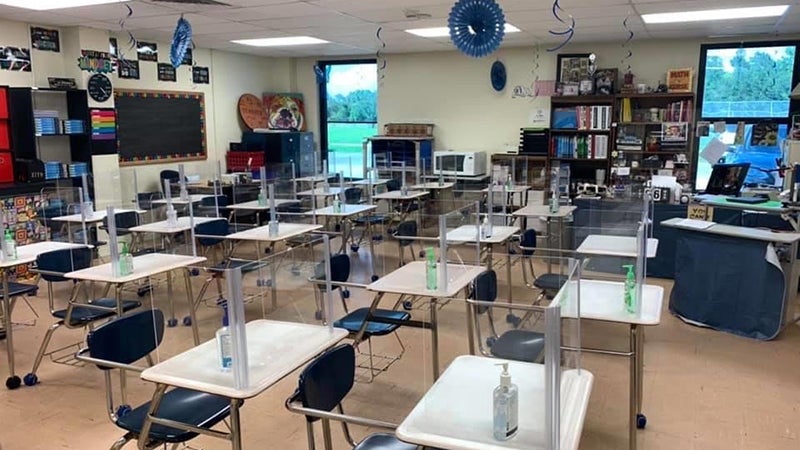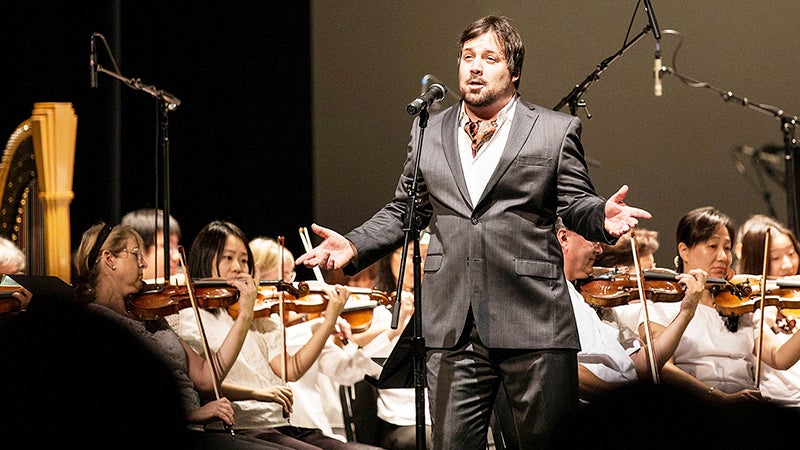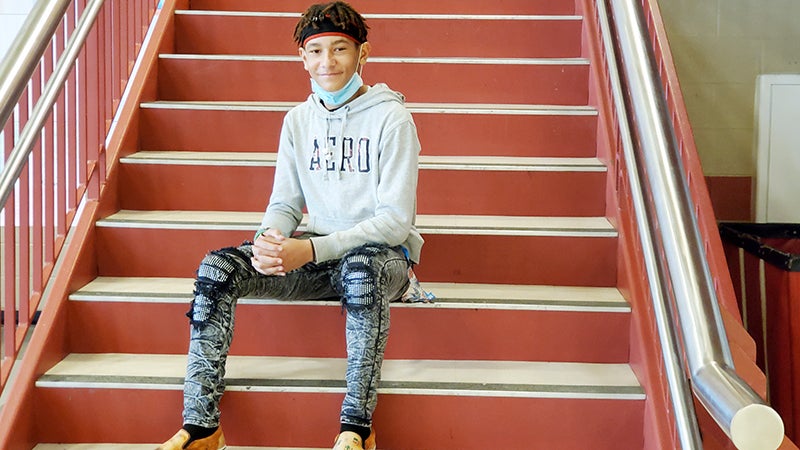Tech, student opportunity: Sabine Pass classroom on cutting edge
Published 5:21 pm Monday, September 3, 2018
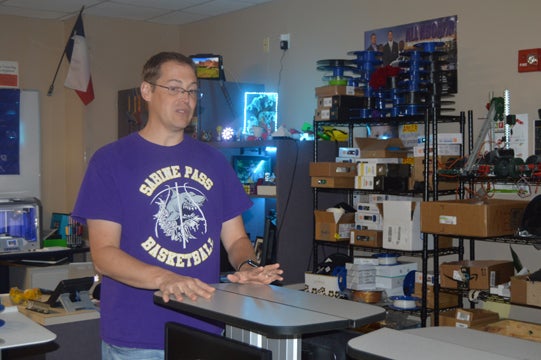
- Sabine Pass teacher Scott Hagedorn opens his Friday morning class discussing possible uses of 3D printing for human tissue, organs and other body parts. (Lorenzo Salinas/The News)
By Lorenzo Salinas
SABINE PASS — In a classroom where discussion begins by highlighting the possibility of printing new organs for people in need, one could tell Scott Hagedorn’s class is not like many others.
Surrounded by an array of computers and little gadgets, a line of 3D printers sits near the back where students could theoretically print anything — including human organs.
“But what’s the one organ we can’t print yet?” Hagedorn asked his morning class.
One student answered “the brain.”
“That’s correct,” Hagedorn said. “That’s because the brain is the only organ that doesn’t regenerate tissue.”
Hagedorn is a teacher with Sabine Pass Independent School District. He teaches grades 8 through 12 along with a middle school class.
He teaches a variety of tech-oriented classes including 3D printing, robotics and graphic design.
Sabine Pass ISD does not have the technological ability to print organs — the necessary printers are found only in research labs considered to be “clean” labs. However, Hagedorn could still highlight some of the many uses of 3D printing overall for his Friday morning class.
Teaching opportunity
Hagedorn said providing real-world opportunities to his students is one of the most important aspects of teaching.
“I think sharing your work with a real audience, someone outside of your classroom, has a huge impact,” he said.
Hagedorn said he is a firm believer of never teaching a student something they could already do.
“I want the kids to learn how to do things. If it is repairing a 3D printer, I’ll show them how to fix it. If it’s calling support or whatever that might be, I want the kids to know how to do that.”
Hagedorn said keeping students engaged was a matter of keeping them busy.
“I think variety is key, as well as flexibility and understanding things they are interested in,” he said. “I try to create projects that line up with what students want to do.”
For instance, students will get to fly a drone, take several photos of a chosen object and then stitch the object together from the photos and print it in the classroom.
3D treats for kids in need
One of the examples of real-world opportunities Hagedorn provides for his students is the chance to give 3D-printed items to children in need.
Hagedorn’s high school students have created toys for children in Early Childhood Intervention, a statewide program for special education students and those with certain disabilities. ECI aids children up to age 3.
“We have some of their therapists come out. They meet with our students, and then we create toys for their students,” Hagedorn said. “These toys seem simple — they might have lids that screw on, pegs of different sizes that can go through one hole — however, these toys are not very common anymore and can be pretty expensive.”
These toys were also made available for free online.
Hagedorn said every time someone downloaded the designs for the toys, the students were “extremely excited.”
“This is having a huge impact on them personally. We do projects for teachers, and the teachers display their work proudly,” Hagedorn said.
“But having someone they don’t know, and knowing their work is having an impact on other people, is beyond description of how much of an impact it has on them.”
He said students would be 3D printing pens and video game controllers for handicapped students in the coming school year.
Background
Hagedorn discovered his love for technological applications only after a few trial runs with other careers.
“I switched majors six times in college,” Hagedorn said. “I originally taught government and history for seniors only in Kansas. I then was a loan officer for awhile and then worked at a marketing company.”
Hagedorn’s passion for technology eventually blossomed and led him to Texas. He was technology director at Hardin-Jefferson before coming over to Sabine Pass.
To date, he has taught 28 different classes — everything from forensic science to history to 3D printing.
Technology upgrades
Technology has certainly changed since Hagedorn first started teaching, usually for the better.
“I’ve gone from a few laptops to one-to-one iPads and one-to-one Chromebooks,” he said. “I have also seen a much larger amount of technology integration throughout the curriculum.”
Accordingly, Hagedorn has his students sign up for Twitter accounts in order to better display their work and to share their Twitter handles where he speaks.
“We’ve drawn a lot of interest from all over the place,” he said. “Besides companies wanting to talk to the students, we’ve had educators all over Texas and the U.S. looking at what the students at Sabine Pass have been doing in trainings and conventions.”
Supportive environment
Hagedorn was quick to credit Sabine Pass with leading the way among local districts in technology.
“I don’t know too many schools that have as many 3D printers as us — period,” he said. “Not only that, but we have a Glowforge (and) drones. I have VEX Robotics sets and the list goes on and on. I don’t know too many places that would buy drones to let students fly.”
As a result, Hagedorn said Sabine Pass was one of the most supportive places he’s ever worked for.
“My wife says I get to play every day, but we’re doing things that you simply don’t get to do at most schools,” he said.
“My students get to experience things and have hands-on training with not only cool technology, but also professional programs like Autodesk Fusion 360 and Photoshop, too.”
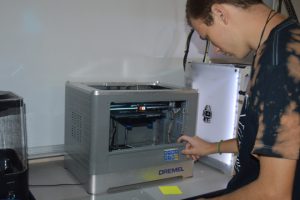
Senior Colin Londonberg problem-shoots a 3D printer in Mr. Hagedorn’s class Friday morning at Sabine Pass School. (Lorenzo Salinas/The News)
Enjoying what they do
Senior students Colin Londonberg and Marissa Peltier both said they enjoy Hagedorn’s class.
“For me, we do a lot of interesting things and it’s a fun class,” Londonberg said.
Pelteir said she likes Hagedorn’s way of introducing a problem for the class to solve.
“He shows us something to work on, and then he sends us to go build it,” she said. “I like figuring it out on my own.”
With the myriad of objects students make, Londonberg said he enjoyed making models of cartoon characters that the class got to spray paint afterward. He showed a replica of popular Japanese manga character Astro Boy as one of his favorites.
Peltier said she loved making toys for the children in Early Childhood Intervention.
“It was wonderful working with the lady who was giving the (toys) to the kids,” she said.
Peltier plans on attending college after graduating and majoring in something related to computers or IT.
Londonberg plans on becoming a mental health therapist after graduation and college.
Sabine Pass leads way
Sabine Pass principal Andy Bates said Hagedorn’s approach to teaching reflects the school’s overall commitment to student excellence.
“The district has made a concerted effort to increase our expectations in the areas of technology and career-readiness,” he said. “It isn’t often easy or simple, but we know it’s necessary to adequately prepare our students for what they will be facing once they leave our campus.”
Bates credited Hagedorn as a large part of that initiative.
“Mr. Hagedorn brings an authentic excitement for what he teaches,” Bates said. “His students can feel that enthusiasm and they get caught up in it as well.”
Bates said student interest in Hagedorn’s classes has only grown with each year and he doesn’t see that stopping anytime soon.


